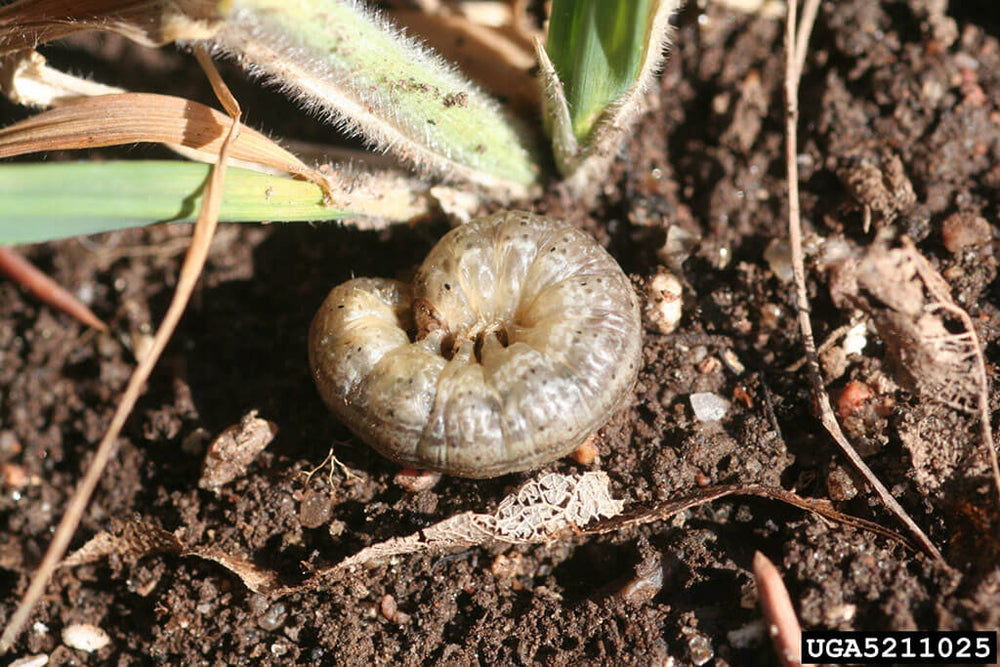
As their name suggests, armyworms move together in large groups, leaving destruction in their wake. They can quickly do serious harm to gardens, crops, and even lawns. To make matters worse, armyworms are prone to attack at night, leaving unsuspecting gardeners to find widespread damage come morning. But you can win the war against armyworms. Learn how to prevent, control, and get rid of armyworms no matter when or where they attack.
How to Get Rid of Armyworms
What are armyworms?
Armyworms are moth larvae. Full-grown armyworms can reach upwards of 1.5 inches long and be yellow, green, gray, or brown, depending on the species and their age. Adult female moths lay several hundred eggs at a time, which then turn into the larvae, who eat foliage with a vengeance for 3 to 4 weeks before going into the soil to pupate and then emerge as adult moths. Depending on where you live, you can have multiple generations of armyworms in a single growing season.
But no matter what species or your location, all armyworms have several things in common. First, they attack and move in large numbers (like an army, hence the name). Second, they have big appetites. When they hatch, the tiny larvae crawl like inchworms, eating leaves to fuel their rapid growth. They can completely skeletonize a plant—leaving only the tough tissue that frames the leaves—very quickly.
It's also important to note that most species of armyworms feed at night, so you may wake up to find considerable damage.
Armyworms prefer young bean, pea, lettuce, and spinach plants. They also feed on agricultural crops such as corn and soybeans, and can wreak havoc on certain types of turfgrass. It's important to note that there are a number of other pests that attack corn, such as corn rootworm, corn earworms, and European corn borer. So, make sure you've narrowed down the culprit before treating if your corn is being attacked.
How do I prevent armyworms?
Because of the severe damage they can cause, preventing armyworms is well worth the effort. The good news is if you're keeping a clean, well-rounded garden, you're well on your way. Here are two critical ways to prevent armyworms as well as a host of other garden pests.
- Attract beneficial insects. Ladybugs and lacewings feed on armyworm eggs. Attract these armyworm predators by growing a variety of flowers that bloom at different times during the growing season, including sweet alyssum and marigolds.
- Keep a clean garden. Armyworms hide during the day under garden debris, especially under dense, leafy canopies. Clean up your garden regularly, gathering and removing fallen leaves, fruits, or dead plant material. Remove weeds or any objects that may offer refuge for insects.
How do I control armyworms?
While an onslaught of armyworms may make you want to run for the hills, take a deep breath! Early action is key. It is important to control armyworms while they are still small and easier to kill. Here are a few ways to remove armyworms from your garden.
- Pick off worms. The easiest method is to hand-pick worms from plants and drop them into soapy water. This works best in small gardens.
- Spray plants with Bt. You can also spray plants with Bt (Bacillus thuringiensis) applied according to label directions. When you spray, worms will ingest the Bt and continue eating leaves for a while but die shortly after. Spray Bt as a preventive treatment if you have had severe armyworm problems in the past.
- Use other pesticides. Apply a product that is designed to target armyworms, such as Ortho® Insect, Mite & Disease 3-in-1, according to label directions.
Need more info and local pesticide recommendations? Contact your regional Extension agent. You can find the nearest Extension office through the Cooperative Extension System map.
It's never fun to find armyworms. However, there are ways you can battle against them and prevent future infestations. By keeping your garden clean and reacting quickly when they do appear, you can win the armyworm war.





 Herbs
Herbs
 Vegetables
Vegetables
 Fruit
Fruit
 Flowers
Flowers
 Succulents
Succulents


